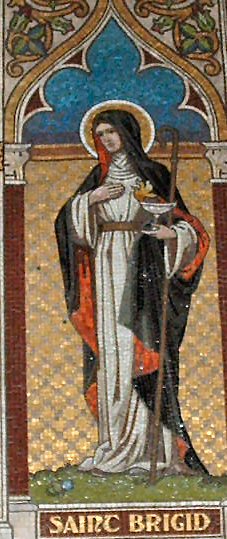Saint Bridget was closely associated with our area. Saint Patrick, said to have planted the yew trees that lent their name to our town also trod our paths. And of course Saint Moninna of Killeavy. The latter too we have already extolled. Now follows a pen portrait of the life of our second National Saint, Bridget!
Today saints are almost exclusively associated with the Roman Catholic Church, one possible reason that
This study was (and is) encouraged because these persons were considered to be excellent examples of how Christ would like us to live our lives and to follow in his path. The recent public outpouring of grief at the deaths of such figures as Mother Theresa and Pope John Paul II indicate the underlying need for such eminent examples in the lives of Christians of all denominations, and many people of other faiths.
The lives of the saints were often written long after their deaths. They are therefore naturally open to dispute and even controversy. At least eight lives of Bridget were written and we cannot always be sure it was one and the same woman. On the other hand, she must have been impressive to inspire such following.
The Annals of Ulster maintain that our Bridget was born in 454 AD and belonged to the ‘eaithech tuathai’ – then a subject people of low social position. Yet tradition has it that her father was a wealthy pagan chieftain named Dubhthach and her mother a Christian slave named Broicsech. Most scholars maintain Bridget was a
Clearly her mother raised her to be a Christian. It’s told that at marriageable age her father tried to arrange likely suitors for her but she refused all offers, determined to become a nun. This she did with the aid of St Malachy and, with seven virgin followers she followed St Mel into Meath. About the year 470 AD she founded her monastery at Kildare (Cill Dara). Her monastery became a centre of learning and spirituality. She also founded a school of art, including metalwork and illumination (artistic enhancement of gospels by scribes) at Kildare. From this work emerged the renowned Book of Kildare – which disappeared at the time of the Reformation.
The Book of Armagh (7th century) imputes that Bridget – with the approval of the Primate of Armagh – exercised some ecclesiastic jurisdiction at Kildare.
At her death in 524 AD Bridget was attended by St Ninnidh. Towards the close of the 9th century, when Viking raids were at their height, her remains were disinterred from the Cathedral at Kildare and taken to Downpatrick where she was interred alongside St Patrick and St Columba.
The symbol of the St Bridget’s Cross, made of straw or rushes, reaches back even to pre-Christian times. Again this is consistent with the fertility symbol: even today the Bridget’s Cross in the Irish rural mind is associated with birth (being hung in calving byres, for example). It was also a symbol of protection (against disease and fire) and healing, as evidenced by the huge number of healing wells dotted throughout the country. Many of these are dedicated to Bridget, most notably that nearest to us at Faughart.
Many miracles were attributed to St Bridget: the changing of water into ale (as with Christ at the Marriage Feast of Cana), the healing of the blind nun, and of the leper (again, reminiscent of Christ), being examples.
The Europe-wide devotion to St Bridget testifies eloquently to the spirituality of her life and the example she set for all of us. St Moninna’s convent at Killeavy was dedicated in her honour.
Bridget was and is renowned for her courage, generosity, zeal, virtue, self-control and compassion. She was the first person to set up a convent in
